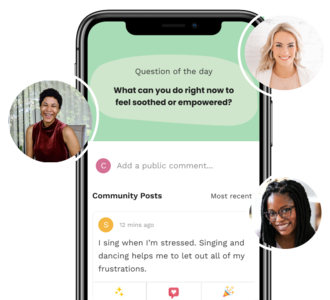Lean Into Your Vulnerability With This 1 Chart
Vulnerability is a buzzword lately—and rightfully so.
Why: Getting familiar and comfortable with vulnerability has the power to shift how we show up within ourselves, in our relationships, in our communities, and in our world.
The truth, though, is that vulnerability can be scary and even unsafe if we practice it without understanding and being in touch with our own sense of safety and boundaries.
To understand how to practice vulnerability in our lives, we first need to understand what it is and how to practice it.
Vulnerability is defined by Brené Brown (whose research about vulnerability has truly changed the cultural narrative) as “risk, uncertainty, and emotional exposure.”
As you may guess, vulnerability doesn’t look one way and isn’t practiced similarly by everyone. Instead, it is a way of showing up in our lives, letting ourselves be fully seen by others, and embracing all of who we are in order to live more fully, whatever that may mean for each of us.
Vulnerability is a roadmap to connection.
It allows us to be supported, held, and witnessed in both our joy and our pain. It connects us to others in a real, human way. It reminds us we aren’t alone, which is one of the most healing experiences we can have with one another.
Vulnerability is a way of showing up in our lives, letting ourselves be fully seen by others, and embracing all of who we are in order to live more fully.
Where vulnerability gets tricky is when we don’t use discernment around when, where, and with whom to practice it. Since vulnerability is inherently risky, often emotionally exposing, and usually uncertain, finding the right timing and people to practice vulnerability with is key.
If you didn’t grow up in a home where emotions were talked about and vulnerability was frequently practiced, you aren’t alone. So many of us weren’t taught about these things, so learning them can feel like a steep curve and a land of unknowns.
That's why I created this Vulnerability Hierarchy to help you begin exploring what vulnerability might look like for you, and who you might feel safest practicing vulnerability with.

The biggest section of this hierarchy is 'within yourself.'
Being vulnerable within ourselves might look like allowing ourselves to feel all our feelings, being honest with ourselves about what we’re experiencing, and reducing avoiding, minimizing, or numbing in order to really be present with what’s happening for us.
When we allow ourselves to be honest about our feelings, emotions, and experiences, we make it a lot easier on ourselves to do the same with those we love and care about. Starting with ourselves is always most important.
Next is ‘with the most trusted person.’
As we explore sharing ourselves honestly with others, it’s important to start with the person we trust the most, as this decreases the risk of feeling too exposed, unsafe, or unseen.
Share today's article with someone who has been vulnerable with you.
Figuring out who you feel most comfortable and safe sharing the deepest parts of yourself with is huge. Whether it’s a family member, therapist, partner, or friend, knowing who we can really trust allows us to create a safe container for vulnerability.
As you move up the hierarchy, you’ll see the community get larger.
This is because we tend to feel less comfortable and safe being vulnerable with the world than we do with the most trusted person in our lives.
Sharing our deepest pains and joys with the world might not feel as contained, supported, or connected. Further, it might lean into performance or over-sharing when we don’t actually feel safe or comfortable doing so, which can lead to moving away from being vulnerable in the first place.
Vulnerability + boundaries = vulnerability Vulnerability – boundaries = not vulnerability
I invite you to use this pyramid to explore these questions:
●︎ How do you hold space for your own emotional experiences and feelings?
●︎ Who are you able to be most vulnerable around? How do you know?
●︎ Are there others you can safely share with? What makes it feel safe?
●︎ What do you feel comfortable sharing on a wider scale? How do you know you’re comfortable with the uncertainty, risk, and emotional exposure it might entail?
●︎ How do you know you aren’t ready to share something?
●︎ In what ways can you practice setting boundaries around vulnerability so it feels more safe and supportive for you?
A few closing tips about vulnerability:
1. Starting where we are, within ourselves, is critical.
Vulnerability starts within. It starts with asking yourself questions, getting curious about your own story around vulnerability, knowing and noticing what arises within you when vulnerability surfaces, recognizing the models for vulnerability you had growing up, and being willing to go on a personal excavation of what being vulnerable looks and feels like to YOU.
2. We get to choose who we’re vulnerable with and what that looks like.
We also get to choose what our boundaries around vulnerability are, and how little or how much we share with any given person, in any given space, and at any given time.
We are in charge of our own vulnerability compass, and tuning into what feels good and not good, what feels safe and not safe, and who feels able to witness our full selves is critical.
3. Vulnerability isn’t about sharing everything all the time.
It’s about knowing we are worthy of having our stories, experiences, and selves seen and witnessed by others (whether one person or one million people), and letting ourselves act from that place with awareness and self-compassion.
Read next: 5 Ways Being Vulnerable Can Make You Happier
Shine is supported by members like you. When you buy through links on our site, we may earn an affiliate commission. See our affiliate disclosure for more info.


